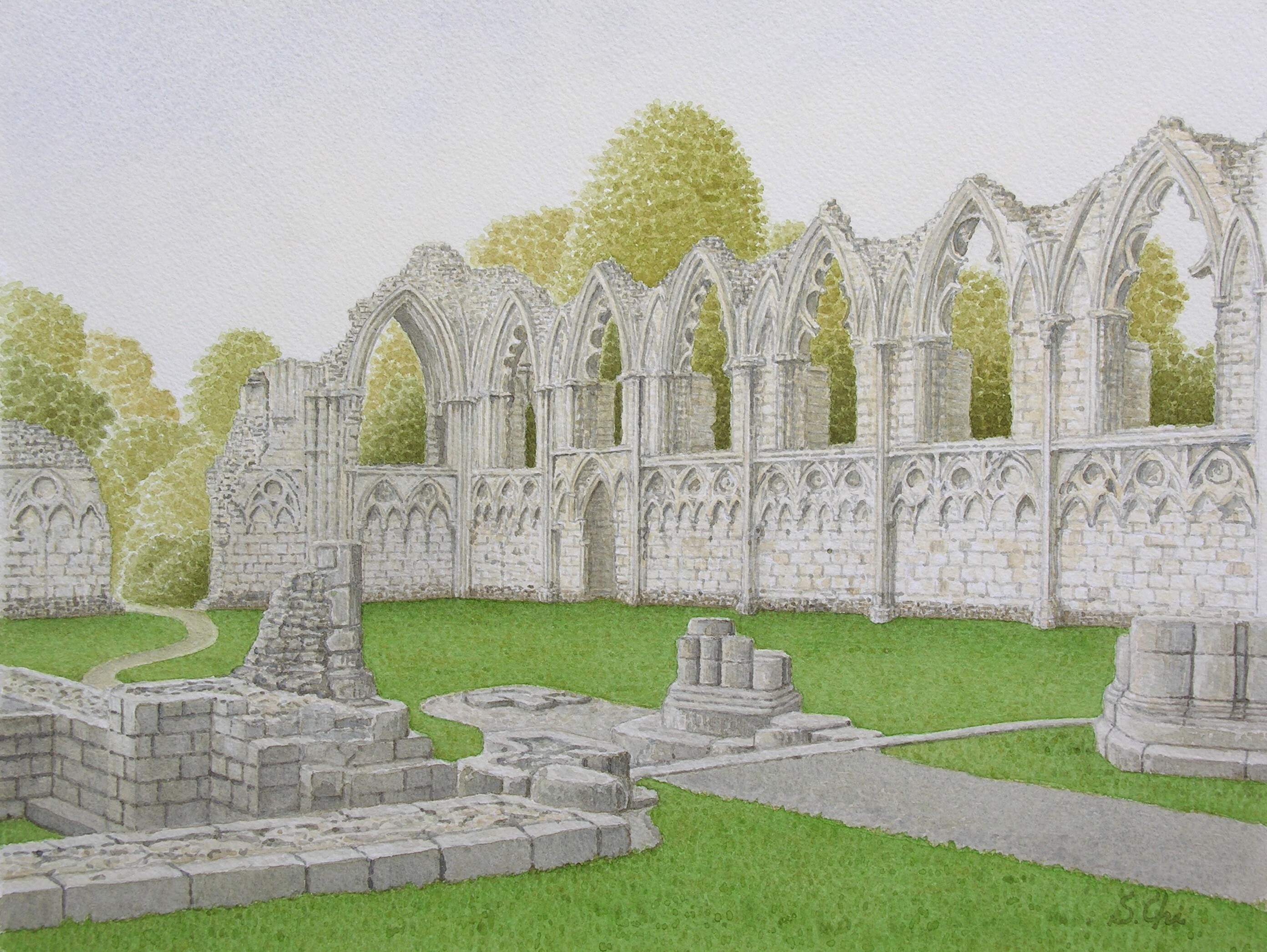
遥かなる わがヨークシャー (Faraway My Yorkshire)
古都ヨーク (York)
22 セント・メアリーズ修道院 (St Mary's Abbey)

ヨークで、街なかの雑踏をさけて静かな時間を過ごしたいと思うならば、ミュージアム・ガーデンの一角を散策するのがいい。わたしの好きなところでもある。
ここはかつて、ベネディクト修道会のなかでも、イングランド北部でもっとも重要とされたセント・メアリーズ修道院があったところである。ほかにもこの一角には、遺跡や歴史的建造物、建物が数多く残っている。
ヨークの旧市街を北にあるブ―サム城門から出てブ―サム通り、メアリーゲイト通りとたどってゆくと、左手にミュージアム・ガーデンの入口がある。かつてのセント・メアリーズ修道院のノルマン式のゲイト・ハウス(門廊)をくぐると、左手の緑地のなかに、修道院の廃墟がある。
この修道院は、1088年に建設がはじまり、14世紀に完成したとされる。ここも1539年に解散させられ、その後、廃墟になっていったところである。いまは、聖堂の壁のほんの一部と、基礎の石だけが残っている。わずかに残された壁には、13世紀後半の装飾的ゴシック様式*の、先の尖った優雅なアーチがならんでいる。
廃墟の南側のそばには――といってもかつてはそこも廃墟の一部であったのだが――ヨークシャー博物館が立っている。
そこには、306年にヨークで帝位についたコンスタンティン大帝像の頭部や、軍神マースの像、ローマのコインなどが展示されている。これらはヨークで発掘されたものであるが、それらを見ていると、あらためてブリテン島がかつてはローマ帝国の一部であったことを思い出す。
ヨークには、ほかにもそのことを思い出させるものが多数ある。たとえば、ヨーク大聖堂の南側に高さが10mくらいの石柱が1本立っているが、これは、4世紀ごろのローマ式建物の円柱である。1967年に大聖堂の改修工事のためにその地下を調査したところ、南翼廊の下から発見されたものだ。
ヨークシャー博物館の右手、つまり南側には、ローマ時代の城壁とその西の角にあった砦マルタンギュラー塔がある。それらの下のほうがローマ時代に築かれたもので、上のほうが中世に継ぎ足して築かれた部分である。それらの石の積み方を見ると、時代によるちがいが一目瞭然としていて、興味深いものがある。300年ごろのローマ時代に築かれた下のほうは、小ぶりで不揃いの石が、やや乱雑に積まれている。それにたいして中世の13世紀に築かれた部分は、大きくて大きさもそろった切石が、きれいに積まれているのである。
マルタンギュラー塔の中には、市内で発掘されたローマ時代の石棺が数個、置かれている。
ヨークシャー博物館の裏、すなわち北東側には、キングズ・マナー(王の館)がある。かつて、修道院の院長の館だったところである。ヘンリー8世は、修道院解散後にここに北部地方院を置き(1540年ごろから1641年まで)、カトリック教徒が多くなにかと問題を起こす北部の、統治の要(かなめ)とした。彼は、1541年に、5度目の王妃キャサリン・ハワードとキングズ・マナーに滞在したことがあった。
スコットランドのジェイムズ6世(在位1567-1625)は、イングランド王ジェイムズ1世(在位1603-25)としての戴冠式のためにロンドンへ向かったが、その途中ヨークに滞在した。彼が宿泊したのも、ここキングズ・マナーであった。
ピューリタン革命時代、ロンドンから逃れてきたチャールズ1世(在位1625-49)は、キングズ・マナーを仮の宮廷とした。
このキングズ・マナーも時代とともに変遷をかさねてきた末に、いまはヨーク大学の施設になっている。
セント・メアリーズ修道院の廃墟をとりかこむ石壁の北の角に、セント・メアリーズ・ハムレットという小さな塔がある。1644年のヨーク包囲戦のとき、議会軍は国王軍の防衛拠点であったキングズ・マナーを攻略しようと、7月16日にセント・メアリーズ・ハムレットを爆破して市内に突入しようとした。しかし国王軍のはげしい抵抗にあい、その作戦は失敗するのだった。
ミュージアム・ガーデンは、時が静かに流れ、いろいろな歴史的な出来事を思い出させてくれる空間である。
If you want to spend quiet time, you would do better to visit the Museum
Gardens, my favorite spot in York.
There are the ruins of St Mary's Abbey, which was the most important Benedictine
monasteries in the north, and many other remains and historic buildings
are also there.
Going out the old town of York from Bootham Bar and walking along Bootham
then Marygate, you will find the entrance to the Museum Gardens. Passing
through the Norman gatehouse of St Mary's Abbey, you can see the ruins
of the abbey lying on the green on the left.
The abbey was founded in 1088 and completed in the 14th century. In 1539
the abbey was dissolved and ruined. Though only a small part of the church
remains now, you can see the elegant arches of window frames on the walls.
The arches were built in the Decorated style, Gothic from the late 13th
century to the first half of the 14th century.
On the place, which used to be a part of the ruins, stands Yorkshire Museum.
Seeing the head of the statue of Constantine the Great, who was proclaimed
Emperor in 306, the statue of Mars and Roman coins there, I realised that
the Britain was a part of the Roman Empire. York is full of such reminders.
In the south of the Minster, a Roman pillar about 30ft high dating back
to the 4th century stands, which was discovered under the south transept
in 1967.
On the right, that is, south-east of the museum, there are the Roman Walls
and Multangular Tower which was a fortress at the west corner of the walls.
It is interesting that there are the obvious diffrences in building methods
between the lower part of them and the upper part. The lower part, constructed
in about 300 of the Roman ages, was built a little roughly. On the other
hand, the upper part, made in the 13th century, was built with the larger
stones with fine medieval masonry.
The several Roman coffins, which were unearthed in York, are placed inside
of Multangular Tower.
Behind Yorkshire Museum, there is King's Manor, the former residence of
the abbot of St Mary's Abbey. Henry VIII established the Council of the
North(c1540-1641) here after the Dissolutions of the Monasteries, and stayed
there with Katherine Howard in 1541. James VI of Scotland also stayed there
on the way to London for the coronation as James I of England in 1603.
During the Civil War, Charles I set his temporary court here in 1642.
At the north corner of the walls which surround the ruins, there stands
St Mary's Hamlet, a small tower. During the Siege of York on the 16th of
June in 1644, the Parliament Army exploded a mine under the tower and tried
to storm King's Manor, the stronghold to defend the city. Their operations
ended in failure because of the determined resistance of the Royalists.
Museum Gardens is a place where time passes tranquilly. It reminded me
of many historic events.
*装飾的ゴシック様式 (Decorated Style) イギリスで13世紀の終わり頃から14世紀の中頃まで盛んに用いられたゴシック様式。幾何学的模様の狭間飾り(窓上部の透かし彫り状の骨組み)、装飾的な外壁などの特徴がある。